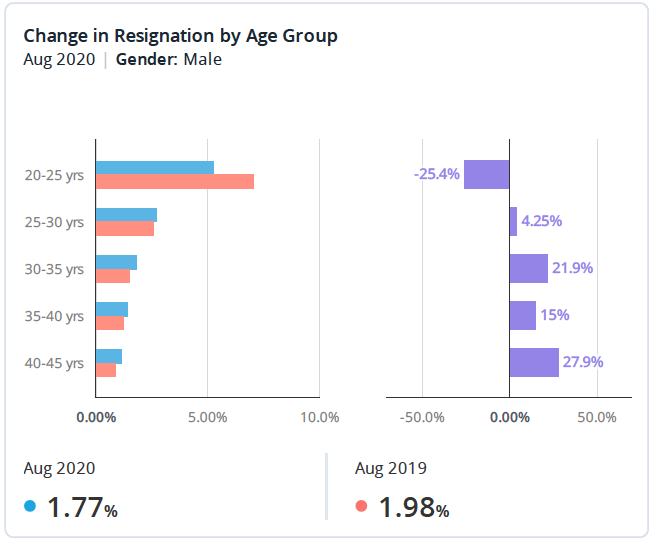Trends in Employee Resignation Rates: Watch Out for Summer 2021
Resignation rates are trending upward for Summer 2021. Managers and mid-career professionals are leading groups in employee turnover.

At a time when mass layoffs have been unfortunately common, there hasn’t been much attention given to resignation activity—voluntary employee turnover.
One might presume that there has been a general fear for job security across the workforce, causing employees to “shelter-in-place” and stick with their current jobs. While the data does show a slight dip in resignations, there has not been that dramatic of a fall. In fact, for a major chunk of the market, resignations have actually increased, meaning people are leaving for new positions.
According to the data, not even a pandemic could keep people from shifting. In the Visier InsightsTM Stop the Exit report, the annualized resignation rate for organizations in our database for January to August 2021 was a staggering 25%, compared to 22% in the same period of 2019, and 18% in a pandemic-ridden period January to August of 2020.
A rise in temperatures and resignations
When we look at the months in which resignation rates have occurred since 2018, an interesting pattern surfaces. This graph illustrates spikes in resignation rates during summer months, even during a pandemic.

Female resignation rates: We see an increase in female resignation rates year over year for the past three years. It’s likely that the majority of recent female resignations is due to the staggering amount of women who left the workforce as the pandemic took form. The cancellation of school and daycare services forced parents (especially women) to become full-time, at-home caretakers.
Male resignation rates: Male resignations decreased in 2020 after two years of increasing resignations. Because male resignations took a pause in 2020, we could anticipate a spike in resignations this coming summer if this pre-pandemic pattern continues.

Employee resignations in 2021 are trending upwards–especially in Tech and Healthcare

Early indications predict past year’s trends are once again starting to evolve, with a growing number of resignations occurring in the March timeframe.
More significantly, it is not increasing in all industries. Healthcare and High Tech are the two sectors that are driving the upward trend. Finance and Manufacturing have yet to see an increase.
For healthcare, there are two prevailing theories: First, after 14 months of incredible strain on the industry, burnout may be a factor in increased resignations. Second, healthcare employees who may have been considering resignations in prior quarters could have delayed the move due to the pandemic, this theory suggests that there is a pent up demand for increased job movement in healthcare.
Resignations are increasing amongst mid-career professionals
The chart below breaks down the change in resignation rates by age group from August 2019 to August 2020. All except the 20-25 age group experienced an increase in resignations during this time.

This data suggests that resignations are occuring most amongst mid-career workers. While we still see a significant resignation rate for early-career professionals, it’s interesting to note that they are the only group whose rate decreased last year. The 40-45 age group experienced the greatest increase in resignations at 27.9%. This suggests that people more established in their careers have continued to shift jobs, despite the pandemic.
This pattern persists regardless of gender. If we look at the next chart, we see both men and women ages 20-25 (entry-level employees) have chosen to hang onto their current positions while other age groups have shifted.

While there has been a massive reduction in women in the workforce in general, both men and women (in mid-career levels) are resigning at higher rates. Let’s explore this further.
A farewell from managers
We decided to take a look at what was happening amongst people in manager roles, since people in those positions are typically mid-career.

This chart shows that while overall resignation rates remained low in 2020, August saw a sharp increase in resignations made by managers.
As of December 2020, the resignation rate for this group was 11.8% higher than the previous year. That’s big!
What could be the reason behind these trends?
As mentioned, it’s highly likely that the 2020 spike in female resignations was due to the pandemic. Women stayed home to take care of the family at a higher percentage during the pandemic. This resignation spike was different because women were not jumping from one employer to the next. They had to exit the workforce altogether. The opposite pattern took place for men.
According to a Gallup analysis, significantly more out-of-work mothers than out-of-work fathers say they stopped working due to childcare demands stemming from school closures. Employers should prioritize programs that reverse this trend. Gender equity is not only good for society, but for business performance too: A Harvard Kennedy School study found that companies with an equal representation of men and women perform better financially than male-dominated firms.
How Visier collects and defines resignation rates
Resignation rates are curated from Visier Benchmarks. This is Visier’s unique database of anonymized, standardized workforce data, which contains over nine million employee records from more than 4000 companies. Resignation rate is the measure which shows the percentage of the total U.S. population that chose to leave their current employer during a specific period of time. Resignation is a type of voluntary turnover.
When looking at resignation rates by age groups, this research uses the following language:
Ages 20 to 25 are considered “entry level” professionals.
Ages 25 to 45 are considered “mid-career” professionals.
Companies included in Visier Benchmarks represent a wide range of industries, including Healthcare, Technology, Financial Services and Insurance, Energy, and Manufacturing. For each of the included companies, Visier ensured a high degree of confidence in both data availability and quality for the topics and time period being covered by this report.
Learn more about retention:
On the Outsmart blog, we write about workforce-related topics like what makes a good manager, how to reduce employee turnover, and employee burnout. We also report on trending topics like the Great Resignation and preparing for a recession, and advise on HR best practices like how to present headcount data to your CEO, metrics every CHRO should track, and connecting people data to business data. But if you really want to know the bread and butter of Visier, read our post about the benefits of people analytics.


